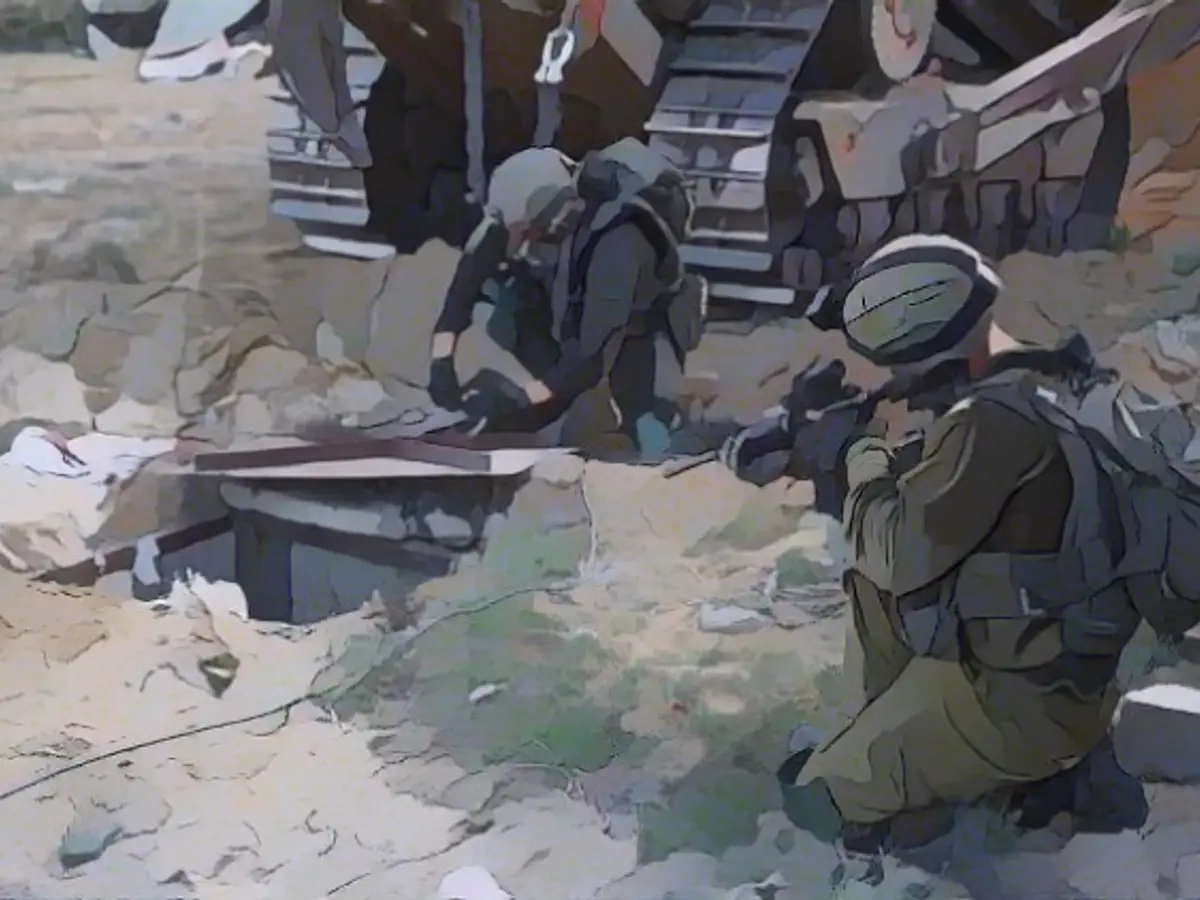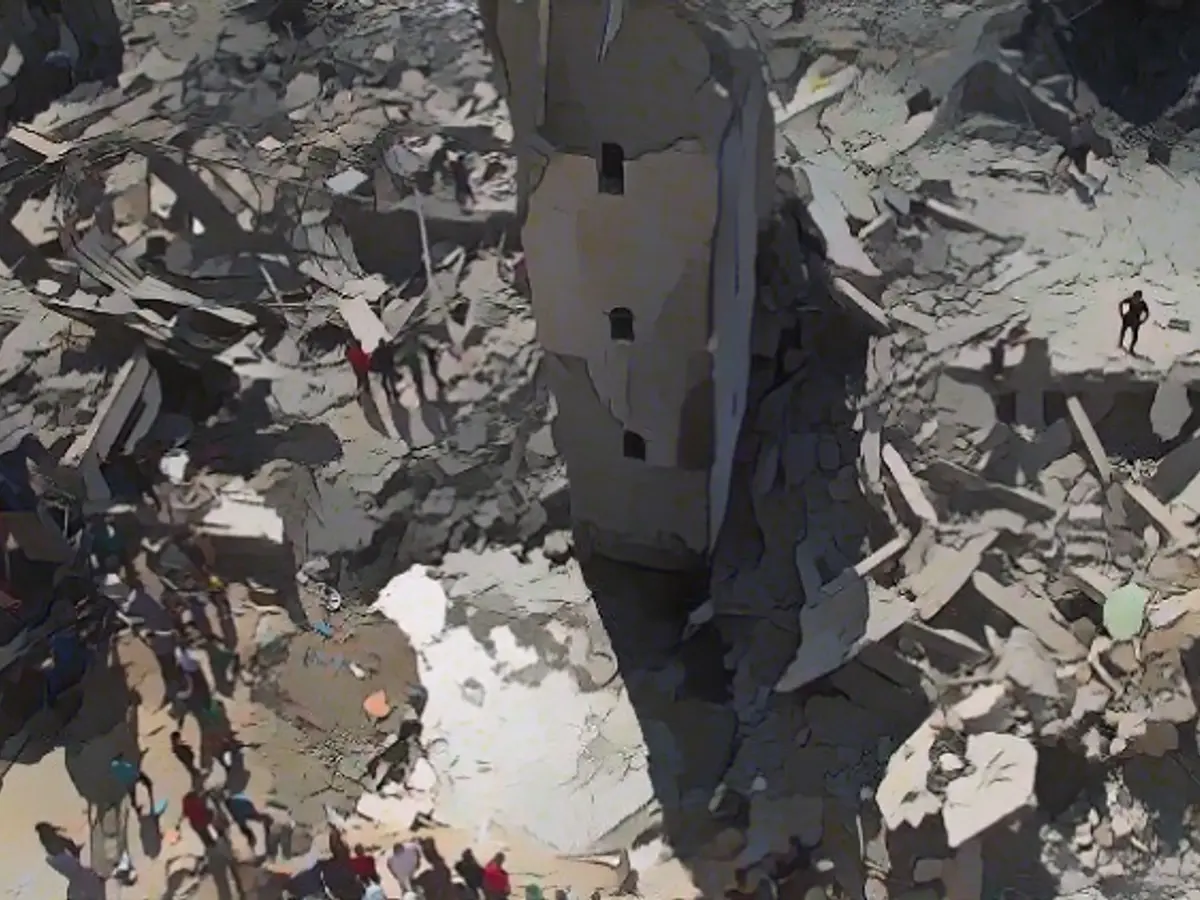When civilian casualties and ruins are intentional
What threatens to lay Gaza City in ruins is a "modern" war, say US experts. 90 percent of the victims in such urban conflicts are civilians, and Gaza is facing the same fate. In the urban melee, the Israeli armed forces are challenged as hardly ever before.
The façade of the building has been ripped out by an explosion. Crouching slightly over piles of rubble, the three soldiers work their way inside. Opposite: multi-storey apartment blocks, no more windows with glass panes, only holes in the concrete. The men don't know from which hole a terrorist could open fire on them. One side wall is still standing, protecting them to the left. On the right is a tank, no protection possible from the front. The foremost soldier breaks away from the wall and fires.
A moment of combat, somewhere in Gaza City, the video is circulating in messenger groups. According to the video, the soldiers belong to the 7th Armored Brigade of the Israeli Defense Forces (IDF). The half-torn house from which they are firing is a Hamas government building captured by Israeli troops.
It is the first time in nine years that the IDF has advanced through Gaza's urban canyons. The scale of the current operation dwarfs that of 2014. After the excess of violence on October 7, it was clear that this attack would mark a turning point for Israel. The previous policy of weakening the terrorist group through limited military operations every few years and containing its capabilities was history. The Israelis had to find a new response to Hamas' furor, and the extent of the humiliation left them with only one option: wipe it out.
At the end of the war, "of course Hamas members will still be alive, and perhaps they will continue to live with their idea," said Israeli security advisor Yakoov Amidror a few days after the attack. But Hamas will no longer have a military apparatus and no ability to attack Israel. "It will no longer exist as a military organization."
This goal is still a long way off and can only be achieved through a bloody urban war, into which Israel has thrown itself with its ground offensive. If you believe John Spencer, a US security expert from the West Point Military Academy who specializes in urban warfare, then this is the face of modern warfare, as the world has seen several times in the last 20 years - in Raqqa in Syria or in Mosul and Fallujah in Iraq.
What these wars have in common is that they were fought among the civilian population. "90 percent of the victims of modern wars are not soldiers, but civilians," says Spencer in his "Urban Warfare Project Podcast". Their theaters become ruins. And there is nothing to suggest to him that it will be any different in Gaza. The scale of this challenge is only just beginning to unfold.
A city beneath the city
A success like the Israeli "capture" of buildings mentioned at the beginning - only a snapshot in the Gaza Strip. The extensive underground tunnel system, known as the "Gaza Metro", offers terrorists the opportunity to move unnoticed between different fighting positions, quickly, criss-crossing. There, too, they can climb back up to the surface, where the Israelis have already driven the enemy away and advanced further, opening fire behind the soldiers.
Gaza is a city under which another city exists in the ground - as military experts describe it. Where the enemy has created an infrastructure up to 40 meters deep where fighters can stay permanently. In many places, it has "power generators, ventilation systems, water pipes and food supplies", Spencer describes in an essay. In his opinion, the tunnels are the decisive element of Hamas' guerrilla warfare strategy.
Therefore, the Israeli advance in Gaza City is never just about attacking the enemy, tracking down ambushes or digging up weapons caches. In Gaza, the IDF basically has to turn over every stone under which an entrance to the tunnel network could be hidden. In videos, soldiers present access hatches in the basements of schools, under bushes on the side of the road, and a few days ago a dislodged child's bed in a private house exposed a meter-deep shaft.

And once the tunnel entrance has been located, the even more difficult task arises: what to do with it? Most military devices for navigation and communication are rendered useless underground, as are conventional night-vision goggles. The IDF has special equipment, but not in the large numbers that are suddenly needed. In some shafts, it is almost impossible to breathe, and firing a weapon in the corridors, which are often only one meter wide and two meters high, is a risky undertaking. "A single defender," summarizes Spencer, "can hold a narrow tunnel against a far superior force."
At first glance, the brute force method, for which Israel's army has ground-penetrating ammunition at its disposal or can also seal tunnels with a bulldozer, seems to be the better option. However, the troops now have to weigh up the effect of these tactics for the first time against the risk of endangering the lives of their compatriots who have been taken hostage. This prohibits a generalized approach and makes it necessary to decide anew in each case.
Above ground, the situation is hardly less complicated and dangerous: Hamas is now also using drones to reconnoitre or attack. The extent to which the use of drones can influence the situation on the battlefield is impressively demonstrated by the example of the war in Ukraine, where neither party currently seems capable of attacking its opponent in a moment of surprise. This shortcoming is more relevant for Israel's troops than for Hamas, which can launch surprise attacks from its tunnels.
Weapons always in the right position
The indispensable advance with heavy tanks and protected vehicles poses a further risk in the narrow urban complex. What is missing is the ability to attack targets from a safe distance. Instead, the mechanized formations themselves can be targeted from all sides. This is because modern anti-tank weapons are portable and therefore ideal for transporting them quickly through the tunnels and positioning them in the most favorable position just before an attack.
In the past, Hamas was known for digging water pipes out of the ground in order to build improvised rockets with limited means. However, it now has an impressive arsenal of state-of-the-art weapons. The terrorist group demonstrated this back in 2014.
That operation lasted fifty days and, according to Spencer, Hamas defended itself "with rockets, mortars, anti-tank missiles, tank shells, machine guns and small arms, mainly deployed from protected bases". In this way, the terrorists can use the difficult urban environment much better for themselves as defenders than the attacking Israelis. It is not without reason that many experts believe that the superiority in combat strength required for a successful attack in an open area increases from 3:1 in the urban environment to 10:1. The invading force must be able to muster ten times more strength to defeat the defenders entrenched in the city.
And the last time IDF soldiers experienced urban combat was almost 20 years ago. In 2005, there was a major operation in Gaza City, while in 2014 it was limited to the outskirts. Military historian Jacob Stoil therefore considers what the troops were able to learn from this for the current operation to be limited. Reservists who fought in 2005 are more interesting.
The problem is that such veterans, who served in special units 20 years ago, first and foremost lack the necessary equipment to venture back into urban combat. While around half of Israel's reservists have been fully equipped to date, more than 100 percent now need equipment at very short notice. According to Stoil, who teaches at the US Army School of Advanced Military Studies and has analyzed the wars in Gaza many times, this is the largest and fastest mobilization in the last 50 years.
All this against the background that Israel is under enormous time pressure, that the clock is ticking in this war - to a much greater extent than in other conflicts. It measures how long the Israelis will have their partners behind them, with a public stance but, more importantly, with military support. This clock is ticking in Washington. "The USA is the determining factor for Israel in most operations," says Stoil in the "Modern Warfare Podcast", adding that the central question for planning the offensive in 2005 was: How much time is left before the US stops the clock? The same question arises now, and with every attack on a Palestinian hospital, with every child's body recovered from the rubble, the hand moves faster.
At the same time, the inhumane Hamas strategy of hiding its weapons, fighters and command centers under hospitals and schools means that Israel cannot make quick decisions. According to Stoil, Hamas has designed almost all civilian construction projects in recent years as dual-use buildings, already planned with the aim of weaving in military infrastructure. "Hamas has designed its defence strategy to maximize the number of civilian casualties and the suffering of the population," says the expert.
The IDF is now trying to deal with this mortgage. While in 2014 they had legal advisors on duty at a higher level as usual, Stoil observes that the question of compliance with international law is much more important in 2023: "Legal advisors are now involved at a tactical level, on the ground, to ensure that any action is in accordance with the laws of war - in terms of proportionality, necessity, differentiation" between military and civilian.
Taking time to legally secure one's own actions, while at the same time hurrying enormously so as not to lose international backing - the contradictory challenges of this Israeli war have been taken to extremes. In addition, there is a battlefield full of human shields, 240 kidnapped compatriots hidden somewhere and a hidden second city of the enemy beneath the battlefield. Each of these challenges may be manageable by a strong army like the Israeli army. "But here it's the sum that counts," says Stoil, and how everything is connected to everything else. "The effect of the individual factors increases exponentially."
In this ongoing conflict, Hamas continues to utilize the Gaza Strip's extensive tunnel system as a means to evade detection and launch attacks, posing significant challenges for the Israeli Defense Forces (IDF). This underground infrastructure, referred to as the "Gaza Metro", allows Hamas operatives to move freely between battle positions and resurface where the IDF has already advanced, potentially ambushing the Israeli forces.
The Israeli war against Hamas in Gaza being a modern, urban conflict, the IDF faces an unprecedented challenge in navigating and neutralizing the enemy's use of weapons hidden within these tunnels. With 90% of modern war casualties being civilians, efforts to locate and eliminate these tunnels must be carried out with utmost care to avoid causing further harm to the non-combatant population.
Source: www.ntv.de








